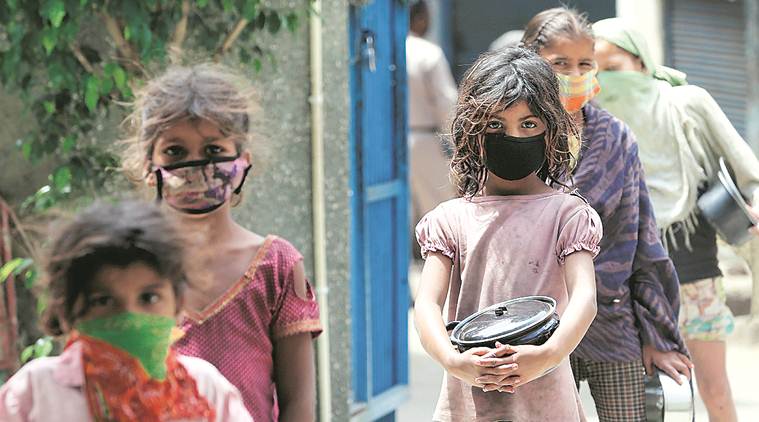- India
- International
Mayapuri Industrial area: In basti of toy sellers , children have new duty — Get food home
Apart from the school, which is a Delhi government hunger relief centre, some local policemen have also been distributing ration by spending their money. But residents say it still falls short.
 Wait for food at Mayapuri slum, Monday. (Express photo by Renuka Puri)
Wait for food at Mayapuri slum, Monday. (Express photo by Renuka Puri)
Eight-year-old Sahiba does not understand the dangers posed by coronavirus, nor does she know why her parents have not left their house at Mayapuri Industrial area for a month.
All she knows is that if she is not among the first ones in line, her family will skip breakfast. The enormity of the weight she bears on her tiny shoulders is something she understands well: “My parents will go hungry if I don’t get food.”
Sahiba’s parents are toy sellers living in Kanchan Basti, which has several others from the same profession. The residents of the slum have been sending their children to collect food and water, since the dal-chawal distributed in a local school is barely enough to feed two people.
Read| Coping with coronavirus: Big challenge for India’s 37%— ‘internal migrants’
Kanchan Basti in Mayapuri Industrial Area, nestled between scrap markets, has around 3,000 houses in an 8-km stretch between Mayapuri police station and Delhi Cantt railway station. It comprises migrants from Lucknow, who have been staying here for over three generations, selling toys and balloons. They buy the toys in bulk from Sadar Bazaar and sell them at middle class neighborhoods in West Delhi, making Rs 300 or more per day.

Some also make kitchen appliances by reworking metal collected from the scrap market. Rajesh Kumar, the General Secretary of IFTU, a trade union, said, “When compared in the ecosystem of labourers in the Mayapuri Industrial Area, they are at the bottom. Their jhuggis are demolished by railway authorities when they extend to the railway property. They are only remembered during elections.”
The main source of food these days is an MCD school nearby. The children know the school well since they study there too, and were dependent on mid-day meals served at the school before the lockdown. Apart from the school, which is a Delhi government hunger relief centre, some local policemen have also been distributing ration by spending their money. But residents say it still falls short.
Read| Delhi: Anxious migrants reel under new crisis
Outside the school, around 12.30 pm, Pitu (12) is busy ordering other children to make a line. They discuss among themselves and choose Gulgul (9) to enter the school first. Gulgul carries a steel plate in her hand, beaming, as Pitu makes her wear a face mask. The children use the same mask among themselves. Minutes later, Gulgul emerges from the school, her plate filled with dal-chawal. She hands over her face mask to the next child, waiting in line.
However, their day starts much earlier, around 6 am. They carry small buckets to a DJB tanker, and it sometimes takes one family almost five hours until their turn arrives. The children then line up outside the school at 10 am and wait for over two hours to get their first meal. They make several trips to the school to collect more portions for their families. School authorities said they feed around 600 people every day. “Children come for second and third portions sometimes. We don’t stop them,” an official said.
After collecting food they return to their homes, usually a 6×6 foot room tied together with a tarpaulin sheet for a roof and garbage bags filled with empty bottles stitched around it to fill yawning gaps. Some rooms have 10-15 people. The nearest toilet is next to a police station nearby.
Sahiba hands out her plate to her father, Dilshad (28), a toy seller who takes a few mouthfuls of the rice and hands over the plate to his wife, Suntita (25). Dilshad has been without work since the lockdown was announced.
His neighbour, Jaggish (28), a balloon seller, has four children between 5 and 7 years of age. They too have been surviving on food distributed in the school and do not have a ration card. With the situation worsening, Jaggish said he has now started sending his children out to beg, something they have never done before.
In a nearby house, toy seller Raju’s daughter, Pooja, flashes a wide grin as she hands over a jar filled with dal to her father. She earns a pat on her back and goes to bed, a discarded cement packet lying on the floor. The family doesn’t have soap, and instead rubs ash from their chulha, thinking it kills germs, before they eat lunch.
A few steps away, Ranjit (50) sits inside his home staring at airguns, miniature tea cups and goggles propped up on a wall. The father of five children spent Rs 10,000 before the lockdown to procure these toys and managed to sell some for three days, earning Rs 2,200, which is over now. “I am waiting for work to begin again, the kids won’t have to stand in line then.”
Apr 26: Latest News
- 01
- 02
- 03
- 04
- 05







































